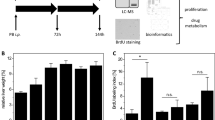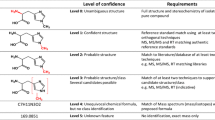Abstract
The antihistaminic drug methapyrilene was withdrawn from the market in 1979 because of hepatocarcinogenicity in rats. Since then, the drug has been used as a model hepatotoxin especially for transcriptomic analyses using material from in vivo studies. Much less transcriptomics data are available from in vitro studies, and no studies have investigated proteomic effects of methapyrilene in vitro. Thus, the present study was aimed to characterize the proteomic response of primary rat hepatocytes to methapyrilene, to broaden our knowledge on the molecular mechanisms of methapyrilene toxicity, and to compare the results of collagen sandwich-cultured hepatocytes to in vivo data. In vitro methapyrilene concentrations (0.39 µM, 6.25 µM, and 100 µM) were chosen to cover an in vivo-relevant range. Based on published pharmacokinetic data they correspond to concentrations in portal vein blood for previously in vivo-tested doses of methapyrilene, up to a concentration showing slight cytotoxicity. Analysis of proteomic alterations by two-dimensional gel electrophoresis and mass-spectrometric protein identification demonstrated consistent and concentration-dependent effects of methapyrilene, in particular on mitochondrial proteins. Data suggest substantial deregulation of amino acid and ammonia metabolism and effects on mitochondrial energy supply pathways. The effects identified in vitro concur well with into previous in vivo observations. Several effects, for example, the influence of methapyrilene on S-adenosylmethionine metabolism, have not been described previously. The data suggest that already non-toxic concentrations of methapyrilene alter components of the intermediary metabolism, such as branched-chain amino acid metabolism, as well as urea and tricarboxylic cycle enzymes. In summary, data substantially add to our knowledge on molecular mechanisms of methapyrilene hepatotoxicity at the protein level.





Similar content being viewed by others
References
Anderson NL, Copple DC, Bendele RA, Probst GS, Richardson FC (1992) Covalent protein modifications and gene expression changes in rodent liver following administration of methapyrilene: a study using two-dimensional electrophoresis. Fundam Appl Toxicol 18(4):570–580
Auman JT, Chou J, Gerrish K et al (2007) Identification of genes implicated in methapyrilene-induced hepatotoxicity by comparing differential gene expression in target and nontarget tissue. Environ Health Perspect 115(4):572–578. https://doi.org/10.1289/ehp.9396
Braeuning A, Sawada S, Oberemm A, Lampen A (2015) Analysis of 3-MCPD- and 3-MCPD dipalmitate-induced proteomic changes in rat liver. Food Chem Toxicol 86:374–384. https://doi.org/10.1016/j.fct.2015.11.010
Craig A, Sidaway J, Holmes E et al (2006) Systems toxicology: integrated genomic, proteomic and metabonomic analysis of methapyrilene induced hepatotoxicity in the rat. J Proteome Res 5(7):1586–1601. https://doi.org/10.1021/pr0503376
De Abrew KN, Overmann GJ, Adams RL et al (2015) A novel transcriptomics based in vitro method to compare and predict hepatotoxicity based on mode of action. Toxicology 328:29–39. https://doi.org/10.1016/j.tox.2014.11.008
Doktorova TY, Ellinger-Ziegelbauer H, Vinken M et al (2012) Comparison of hepatocarcinogen-induced gene expression profiles in conventional primary rat hepatocytes with in vivo rat liver. Arch Toxicol 86(9):1399–1411. https://doi.org/10.1007/s00204-012-0847-x
Ellinger-Ziegelbauer H, Stuart B, Wahle B, Bomann W, Ahr HJ (2005) Comparison of the expression profiles induced by genotoxic and nongenotoxic carcinogens in rat liver. Mutat Res 575(1–2):61–84. https://doi.org/10.1016/j.mrfmmm.2005.02.004
Frenzel F, Oberemm A, Lampen A, Braeuning A (2018) Proteomic effects of repeated-dose oral exposure to 2-monochloropropanediol and its dipalmitate in rat testes. Food Chem Toxicol 116(Pt B):354–359. https://doi.org/10.1016/j.fct.2018.04.055
Gorg A, Obermaier C, Boguth G, et al. (2000) The current state of two-dimensional electrophoresis with immobilized pH gradients. Electrophoresis 21(6):1037–1053. https://doi.org/10.1002/(SICI)1522-2683(20000401)21:6%3C1037::AID-ELPS1037%3E3.0.CO;2-V
Grinberg M, Stöber RM, Edlund K et al (2014) Toxicogenomics directory of chemically exposed human hepatocytes. Arch Toxicol 88(12):2261–2287. https://doi.org/10.1007/s00204-014-1400-x
Hamadeh HK, Knight BL, Haugen AC et al (2002) Methapyrilene toxicity: anchorage of pathologic observations to gene expression alterations. Toxicol Pathol 30(4):470–482. https://doi.org/10.1080/01926230290105712
Heise T, Schug M, Storm D et al (2012) In vitro–in vivo correlation of gene expression alterations induced by liver carcinogens. Curr Med Chem 19(11):1721–1730
Hengstler JG, Utesch D, Steinberg P et al (2000) Cryopreserved primary hepatocytes as a constantly available in vitro model for the evaluation of human and animal drug metabolism and enzyme induction. Drug Metab Rev 32(1):81–118. https://doi.org/10.1081/DMR-100100564
Hernandez L, Allen PT, Poirier LA, Lijinsky W (1989) S-Adenosylmethionine, S-adenosylhomocysteine and DNA methylation levels in the liver of rats fed methapyrilene and analogs. Carcinogenesis 10(3):557–562
Huang Q, Jin X, Gaillard ET et al (2004) Gene expression profiling reveals multiple toxicity endpoints induced by hepatotoxicants. Mutat Res 549(1–2):147–167. https://doi.org/10.1016/j.mrfmmm.2003.12.020
Kindrat I, Dreval K, Shpyleva S et al (2017) Effect of methapyrilene hydrochloride on hepatic intracellular iron metabolism in vivo and in vitro. Toxicol Lett 281:65–73. https://doi.org/10.1016/j.toxlet.2017.09.011
Krug AK, Kolde R, Gaspar JA et al (2013) Human embryonic stem cell-derived test systems for developmental neurotoxicity: a transcriptomics approach. Arch Toxicol. 87(1):123–143. https://doi.org/10.1007/s00204-012-0967-3
Leitch AC, Probert PME, Shayman JA, Meyer SK, Kass GEN, Wright MC (2017) B-13 progenitor-derived hepatocytes (B-13/H cells) model lipid dysregulation in response to drugs and chemicals. Toxicology 386:120–132. https://doi.org/10.1016/j.tox.2017.05.014
Lijinsky W (1984) Chronic toxicity tests of pyrilamine maleate and methapyrilene hydrochloride in F344 rats. Food Chem Toxicol 22(1):27–30
Lijinsky W, Reuber MD, Blackwell BN (1980) Liver tumors induced in rats by oral administration of the antihistaminic methapyrilene hydrochloride. Science 209(4458):817–819
Lijinsky W, Knutsen G, Reuber MD (1983) Failure of methapyrilene to induce tumors in hamsters or guinea pigs. J Toxicol Environ Health 12(4–6):653–657. https://doi.org/10.1080/15287398309530457
Man WJ, White IR, Bryant D, et al. (2002) Protein expression analysis of drug-mediated hepatotoxicity in the Sprague-Dawley rat. Proteomics 2(11):1577–1585. https://doi.org/10.1002/1615-9861(200211)2:11%3C1577::AID-PROT1577%3E3.0.CO;2-G
Mielke H, Anger LT, Schug M, Hengstler JG, Stahlmann R, Gundert-Remy U (2011) A physiologically based toxicokinetic modelling approach to predict relevant concentrations for in vitro testing. Arch Toxicol 85(6):555–563. https://doi.org/10.1007/s00204-010-0612-y
Mirsalis JC (1987) Genotoxicity, toxicity, and carcinogenicity of the antihistamine methapyrilene. Mutat Res 185(3):309–317
Oberemm A, Ahr HJ, Bannasch P et al (2009) Toxicogenomic analysis of N-nitrosomorpholine induced changes in rat liver: comparison of genomic and proteomic responses and anchoring to histopathological parameters. Toxicol Appl Pharmacol 241(2):230–245. https://doi.org/10.1016/j.taap.2009.08.020
Oberemm A, Braun M, Sawada S et al (2017) Lanthanum chloride precipitation-based toxicoproteomic analysis of 3-monochloropropane-1,2-diol toxicity in rat kidney reveals involvement of extracellular signal-regulated kinase 2. Arch Toxicol 91(10):3247–3260. https://doi.org/10.1007/s00204-017-1959-0
Omura K, Kiyosawa N, Uehara T et al (2007) Gene expression profiling of rat liver treated with serum triglyceride-decreasing compounds. J Toxicol Sci 32(4):387–399
Ozden S, Turgut Kara N, Sezerman OU et al (2015) Assessment of global and gene-specific DNA methylation in rat liver and kidney in response to non-genotoxic carcinogen exposure. Toxicol Appl Pharmacol 289(2):203–212. https://doi.org/10.1016/j.taap.2015.09.023
Rabilloud T (2000) Detecting proteins separated by 2-D gel electrophoresis. Anal Chem 72(1):48A–55A
Richardson FC, Horn DM, Anderson NL (1994) Dose-responses in rat hepatic protein modification and expression following exposure to the rat hepatocarcinogen methapyrilene. Carcinogenesis 15(2):325–329
Sawada S, Oberemm A, Buhrke T et al (2015) Proteomic analysis of 3-MCPD and 3-MCPD dipalmitate toxicity in rat testis. Food Chem Toxicol 83:84–92. https://doi.org/10.1016/j.fct.2015.06.002
Sawada S, Oberemm A, Buhrke T, Merschenz J, Braeuning A, Lampen A (2016) Proteomic analysis of 3-MCPD and 3-MCPD dipalmitate-induced toxicity in rat kidney. Arch Toxicol 90:1437–1448. https://doi.org/10.1007/s00204-015-1576-8
Schug M, Heise T, Bauer A et al (2008) Primary rat hepatocytes as in vitro system for gene expression studies: comparison of sandwich, Matrigel and 2D cultures. Arch Toxicol 82(12):923–931. https://doi.org/10.1007/s00204-008-0375-x
Schug M, Stober R, Heise T et al (2013) Pharmacokinetics explain in vivo/in vitro discrepancies of carcinogen-induced gene expression alterations in rat liver and cultivated hepatocytes. Arch Toxicol 87(2):337–345. https://doi.org/10.1007/s00204-012-0999-8
Schultrich K, Frenzel F, Oberemm A, Buhrke T, Braeuning A, Lampen A (2017) Comparative proteomic analysis of 2-MCPD- and 3-MCPD-induced heart toxicity in the rat. Arch Toxicol. https://doi.org/10.1007/s00204-016-1927-0
Shpyleva S, Dreval K, de Conti A et al (2017) Editor’s highlight: organ-specific epigenetic changes induced by the nongenotoxic liver carcinogen methapyrilene in fischer 344 rats. Toxicol Sci. 156(1):190–198. https://doi.org/10.1093/toxsci/kfw242
Uehara T, Hirode M, Ono A et al (2008a) A toxicogenomics approach for early assessment of potential non-genotoxic hepatocarcinogenicity of chemicals in rats. Toxicology 250(1):15–26. https://doi.org/10.1016/j.tox.2008.05.013
Uehara T, Kiyosawa N, Hirode M et al (2008b) Gene expression profiling of methapyrilene-induced hepatotoxicity in rat. J Toxicol Sci 33(1):37–50
Waring JF, Ulrich RG, Flint N et al (2004) Interlaboratory evaluation of rat hepatic gene expression changes induced by methapyrilene. Environ Health Perspect 112(4):439–448
Acknowledgements
The work was supported by the German Federal Ministry of Education and Research [grant no. 0313854A] and the German Federal Institute for Risk Assessment (Grant No. 1322- 416). Technical assistance by Christine Meckert, Christel Rozycki and Stefanie Sawada is greatly acknowledged. The authors also thank M. Schug for help with hepatocyte preparation.
Author information
Authors and Affiliations
Corresponding author
Ethics declarations
Conflict of interest
The authors declare that they have no conflict of interest.
Electronic supplementary material
Below is the link to the electronic supplementary material.
Rights and permissions
About this article
Cite this article
Braeuning, A., Oberemm, A., Heise, T. et al. In vitro proteomic analysis of methapyrilene toxicity in rat hepatocytes reveals effects on intermediary metabolism. Arch Toxicol 93, 369–383 (2019). https://doi.org/10.1007/s00204-018-2360-3
Received:
Accepted:
Published:
Issue Date:
DOI: https://doi.org/10.1007/s00204-018-2360-3




